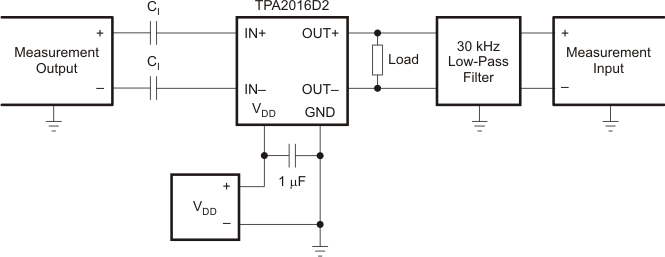SLOS524E June 2008 – May 2016 TPA2016D2
PRODUCTION DATA.
- 1 Features
- 2 Applications
- 3 Description
- 4 Revision History
- 5 Device Comparison Table
- 6 Pin Configuration and Functions
- 7 Specifications
- 8 Parameter Measurement Information
- 9 Detailed Description
- 10Application and Implementation
- 11Power Supply Recommendations
- 12Layout
- 13Device and Documentation Support
- 14Mechanical, Packaging, and Orderable Information
Package Options
Mechanical Data (Package|Pins)
Thermal pad, mechanical data (Package|Pins)
- RTJ|20
Orderable Information
8 Parameter Measurement Information
All parameters are measured according to the conditions described in Specifications. Figure 25 shows the setup used for the typical characteristics of the test device.

1. All measurements were taken with a 1-μF CI (unless otherwise noted.)
2. A 33-μH inductor was placed in series with the load resistor to emulate a small speaker for efficiency measurements.
3. The 30-kHz low-pass filter is required, even if the analyzer has an internal low-pass filter. An RC low-pass filter (1 kΩ 4.7 nF) is used on each output for the data sheet graphs.
4. All THD + N graphs are taken with outputs out of phase (unless otherwise noted). All data is taken on left channel.
5. All data is taken on the DSBGA package unless otherwise noted.
Figure 25. Test Setup for Graphs